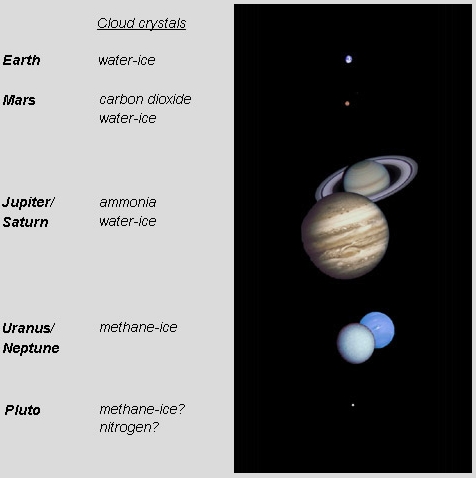Halos on other worlds
Halos on Other Worlds: Exploring the Extraterrestrial Skies
The mesmerizing phenomenon of halos, commonly observed in Earth's atmosphere, may take on even more extraordinary forms in the skies of other worlds. While we may not have had the chance to witness these extraterrestrial halos firsthand, scientists can make predictions about their existence and appearance by studying the crystal structures and optical properties of the clouds on these distant planets and moons.
Earth's Clouds: Just the Beginning
As we venture beyond our home planet, we encounter a diverse range of celestial bodies with atmospheres that harbor potential halo-forming crystals. Let's take a closer look at some of these fascinating worlds:
-
Mars: The Red Planet possesses clouds composed of carbon dioxide crystals and traces of water-ice cirrus, making it a possible host for halos. These unique crystals may create a distinct halo display in Mars' sky.
-
Jupiter and Saturn: These gas giants boast multidecked exotic clouds, where ammonia crystals and ordinary water-ice crystals coexist. The combination of these crystals could produce stunning halos, adding a touch of otherworldly beauty to their atmospheres.
-
Uranus and Neptune: The colder giants in our solar system are shrouded in methane-ice clouds. Here, methane-ice crystals dominate, potentially leading to the formation of their own ethereal halos. Additionally, tiny Pluto may occasionally witness halos arising from crystalline nitrogen and methane.
Moons Unveiling Their Halo Secrets
It's not just planets that hold the potential for halo displays; their moons can also harbor atmospheres or eruptive events that give rise to halo-forming crystals. Let's explore some examples:
-
Jupiter's Moon Io: With its active volcanoes, Io presents a unique opportunity for the creation of monoclinic sulfur crystals and other peculiar entities. These volcanic eruptions may produce crystals capable of generating their own distinctive halos.
-
Neptune's Moon Triton: The enigmatic moon Triton features geysers that emit liquid nitrogen. This intriguing phenomenon could result in rare showers of nitrogen crystals, offering a captivating spectacle in Neptune's sky.
The Intriguing Realm of Extraterrestrial Halos
As we continue to explore the mysteries of our solar system, we realize that reality can be stranger than fiction. The discoveries made thus far have surpassed our wildest imaginations. Although we haven't directly observed halos on other worlds, scientific predictions based on crystal structures and optical properties provide us with a glimpse into the potential wonders awaiting us:
- The appearance of halos on other worlds may vary significantly from those observed on Earth, as the crystal compositions and atmospheric conditions differ.
- The crystal structures present in the clouds of these celestial bodies play a crucial role in determining the shape and intensity of their halos.
- Exotic crystals, such as ammonia, methane-ice, and carbon dioxide crystals, may contribute to the creation of stunning halo displays in extraterrestrial skies.
- The unique combination of crystal types found on gas giants like Jupiter and Saturn adds an extra layer of complexity to their halo formations.
- Volcanic activity on moons like Io can give rise to crystals that are not commonly found on Earth, potentially leading to unprecedented halo phenomena.
- The rarity and infrequency of certain atmospheric events, such as nitrogen showers on Triton, make the occurrence of halos on some celestial bodies even more elusive and captivating.
The study of halos on other worlds is an ongoing endeavor, driven by our insatiable curiosity about the wonders of the universe. With each new discovery, we gain a deeper understanding of the intricacies of atmospheric optics beyond Earth's boundaries. While we may not have the privilege of witnessing these extraterrestrial halos firsthand, we can marvel at the possibilities they hold and appreciate the astonishing diversity of our cosmic neighborhood.

Halos from octahedral ammonia crystals as might exist in the cold high level clouds of Jupiter and Saturn. The 42° circular halo has four associated sundogs. The inner halos are produced by rays reflected within the crystal.
The skies of other planets are too often portrayed with Earthlike halos - they are likely to be more outlandish! Can we say whether there are halos and what they would look like? If we know the crystal structures and optical properties of the crystals in their clouds we can indeed predict them.
Outwards from the sun, Earth is the first planet with significant clouds containing large crystals. Mars has clouds of potentially halo forming carbon dioxide crystals plus traces of water-ice cirrus. The gas giants Jupiter and Saturn have multidecked exotic clouds. There, ammonia crystals as well as ordinary water-ice could make halos shine. The colder giants, Uranus and Neptune, have methane-ice clouds and tiny Pluto might occasionally see halos from crystalline nitrogen and methane.
Moons too have atmospheres or eruptions of possible halo forming crystals. Volcanos on Jupiter's Io could produce monoclinic sulfur and other strange entities. The liquid nitrogen geysers on Neptune's Triton might give rare showers of nitrogen crystals. Far fetched? The exploration of the Solar System has so far shown it to be stranger than was ever imagined.

Note: this article has been automatically converted from the old site and may not appear as intended. You can find the original article here.
Reference Atmospheric Optics
If you use any of the definitions, information, or data presented on Atmospheric Optics, please copy the link or reference below to properly credit us as the reference source. Thank you!
-
<a href="https://atoptics.co.uk/blog/halos-on-other-worlds/">Halos on other worlds</a>
-
"Halos on other worlds". Atmospheric Optics. Accessed on December 22, 2024. https://atoptics.co.uk/blog/halos-on-other-worlds/.
-
"Halos on other worlds". Atmospheric Optics, https://atoptics.co.uk/blog/halos-on-other-worlds/. Accessed 22 December, 2024
-
Halos on other worlds. Atmospheric Optics. Retrieved from https://atoptics.co.uk/blog/halos-on-other-worlds/.